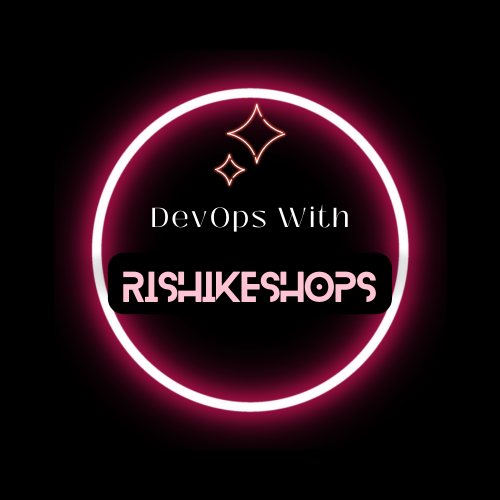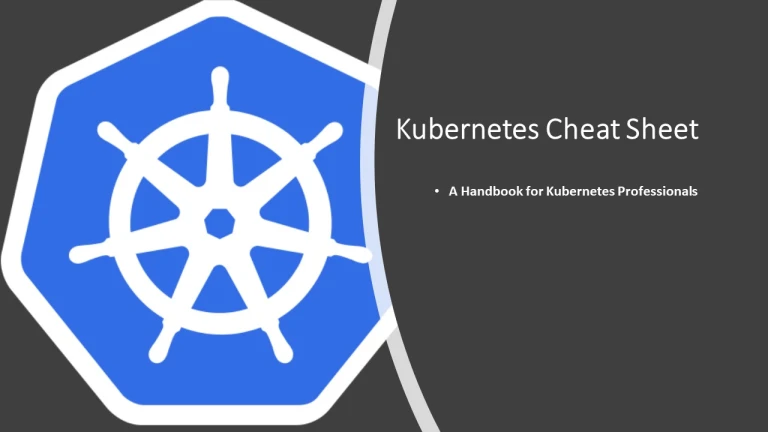Get the Latest Kubernetes Cheat Sheet for Simplifying Container Orchestration
 Rushikesh Mashidkar
Rushikesh MashidkarTable of contents
- Common Commands
- Check Performance
- Resources Deletion
- Log & Conf Files
- Pod
- Label & Annontation
- Deployment & Scale
- Quota & Limits & Resource
- Service
- Secrets
- StatefulSet
- Volumes & Volume Claims
- Events & Metrics
- Node Maintenance
- Namespace & Security
- Network
- Patch
- Extenstions
- Components & Services


Kubernetes is an open-source container-orchestration system for automating application deployment, scaling, and management. It was originally designed by Google and is now maintained by the Cloud Native Computing Foundation.
Common Commands
| Name | Command |
| Run curl test temporarily | kubectl run --rm mytest --image=yauritux/busybox-curl -it |
| Run wget test temporarily | kubectl run --rm mytest --image=busybox -it |
| Run nginx deployment with 2 replicas | kubectl run my-nginx --image=nginx --replicas=2 --port=80 |
| Run nginx pod and expose it | kubectl run my-nginx --restart=Never --image=nginx --port=80 --expose |
| Run nginx deployment and expose it | kubectl run my-nginx --image=nginx --port=80 --expose |
| Set namespace preference | kubectl config set-context <context_name> --namespace=<ns_name> |
| List pods with nodes info | kubectl get pod -o wide |
| List everything | kubectl get all --all-namespaces |
| Get all services | kubectl get service --all-namespaces |
| Show nodes with labels | kubectl get nodes --show-labels |
| Validate yaml file with dry run | kubectl create --dry-run --validate -f pod-dummy.yaml |
| Start a temporary pod for testing | kubectl run --rm -i -t --image=alpine test-$RANDOM -- sh |
| kubectl run shell command | kubectl exec -it mytest -- ls -l /etc/hosts |
| Get system conf via configmap | kubectl -n kube-system get cm kubeadm-config -o yaml |
| Get deployment yaml | kubectl -n denny-websites get deployment mysql -o yaml |
| Explain resource | kubectl explain pods, kubectl explain svc |
| Watch pods | kubectl get pods -n wordpress --watch |
| Query healthcheck endpoint | curl -L https://127.0.0.1:10250/healthz |
| Open a bash terminal in a pod | kubectl exec -it storage sh |
| Check pod environment variables | kubectl exec redis-master-ft9ex env |
| Enable kubectl shell autocompletion | echo "source <(kubectl completion bash)" >>~/.bashrc, and reload |
| Use minikube dockerd in your laptop | eval $(minikube docker-env), No need to push docker hub any more |
| Kubectl apply a folder of yaml files | kubectl apply -R -f . |
| Get services sorted by name | kubectl get services –sort-by=.metadata.name |
| Get pods sorted by restart count | kubectl get pods –sort-by=’.status.containerStatuses[0].restartCount’ |
| Ubuntu install kubectl | "deb https://apt.kubernetes.io/ kubernetes-xenial main" |
Check Performance
| Name | Command |
| Get node resource usage | kubectl top node |
| Get pod resource usage | kubectl top pod |
| Get resource usage for a given pod | kubectl top <podname> --containers |
| List resource utilization for all containers | kubectl top pod --all-namespaces --containers=true |
Resources Deletion
| Name | Command |
| Delete pod | kubectl delete pod/<pod-name> -n <my-namespace> |
| Delete pod by force | kubectl delete pod/<pod-name> --grace-period=0 --force |
| Delete pods by labels | kubectl delete pod -l env=test |
| Delete deployments by labels | kubectl delete deployment -l app=wordpress |
| Delete all resources filtered by labels | kubectl delete pods,services -l name=myLabel |
| Delete resources under a namespace | kubectl -n my-ns delete po,svc --all |
| Delete persist volumes by labels | kubectl delete pvc -l app=wordpress |
| Delete statefulset only (not pods) | kubectl delete sts/<stateful_set_name> --cascade=false |
Log & Conf Files
| Name | Comment |
| Config folder | /etc/kubernetes/ |
| Certificate files | /etc/kubernetes/pki/ |
| Credentials to API server | /etc/kubernetes/kubelet.conf |
| Superuser credentials | /etc/kubernetes/admin.conf |
| kubectl config file | ~/.kube/config |
| Kubernets working dir | /var/lib/kubelet/ |
| Docker working dir | /var/lib/docker/, /var/log/containers/ |
| Etcd working dir | /var/lib/etcd/ |
| Network cni | /etc/cni/net.d/ |
| Log files | /var/log/pods/ |
| log in worker node | /var/log/kubelet.log, /var/log/kube-proxy.log |
| log in master node | kube-apiserver.log, kube-scheduler.log, kube-controller-manager.log |
| Env | /etc/systemd/system/kubelet.service.d/10-kubeadm.conf |
| Env | export KUBECONFIG=/etc/kubernetes/admin.conf |
Pod
| Name | Command |
| List all pods | kubectl get pods |
| List pods for all namespace | kubectl get pods -all-namespaces |
| List all critical pods | kubectl get -n kube-system pods -a |
| List pods with more info | kubectl get pod -o wide, kubectl get pod/<pod-name> -o yaml |
| Get pod info | kubectl describe pod/srv-mysql-server |
| List all pods with labels | kubectl get pods --show-labels |
| List running pods | kubectl get pods –field-selector=status.phase=Running |
| Get Pod initContainer status | kubectl get pod --template '{.status.initContainerStatuses}' <pod-name> |
| kubectl run command | kubectl exec -it -n “$ns” “$podname” – sh -c “echo $msg >>/dev/err.log” |
| Watch pods | kubectl get pods -n wordpress --watch |
| Get pod by selector | kubectl get pods –selector=”app=syslog” -o jsonpath='{.items[*].metadata.name}’ |
| List pods and images | kubectl get pods -o=’custom-columns=PODS:.metadata.name,Images:.spec.containers[*].image’ |
| List pods and containers | -o=’custom-columns=PODS:.metadata.name,CONTAINERS:.spec.containers[*].name’ |
Label & Annontation
| Name | Command |
| Filter pods by label | kubectl get pods -l owner=denny |
| Manually add label to a pod | kubectl label pods dummy-input owner=denny |
| Remove label | kubectl label pods dummy-input owner- |
| Manually add annonation to a pod | kubectl annotate pods dummy-input my-url=https://dennyzhang.com |
Deployment & Scale
| Name | Command |
| Scale out | kubectl scale --replicas=3 deployment/nginx-app |
| online rolling upgrade | kubectl rollout app-v1 app-v2 --image=img:v2 |
| Roll backup | kubectl rollout app-v1 app-v2 --rollback |
| List rollout | kubectl get rs |
| Check update status | kubectl rollout status deployment/nginx-app |
| Check update history | kubectl rollout history deployment/nginx-app |
| Pause/Resume | kubectl rollout pause deployment/nginx-deployment, resume |
| Rollback to previous version | kubectl rollout undo deployment/nginx-deployment |
Quota & Limits & Resource
| Name | Command |
| List Resource Quota | kubectl get resourcequota |
| List Limit Range | kubectl get limitrange |
| Customize resource definition | kubectl set resources deployment nginx -c=nginx --limits=cpu=200m |
| Customize resource definition | kubectl set resources deployment nginx -c=nginx --limits=memory=512Mi |
Service
| Name | Command |
| List all services | kubectl get services |
| List service endpoints | kubectl get endpoints |
| Get service detail | kubectl get service nginx-service -o yaml |
| Get service cluster ip | kubectl get service nginx-service -o go-template='{.spec.clusterIP}’ |
| Get service cluster port | kubectl get service nginx-service -o go-template='{(index .spec.ports 0).port}’ |
| Expose deployment as lb service | kubectl expose deployment/my-app --type=LoadBalancer --name=my-service |
| Expose service as lb service | kubectl expose service/wordpress-1-svc --type=LoadBalancer --name=ns1 |
Secrets
| Name | Command |
| List secrets | kubectl get secrets --all-namespaces |
| Generate secret | echo -n 'mypasswd', then redirect to base64 -decode |
| Create secret from cfg file | kubectl create secret generic db-user-pass –from-file=./username.txt |
StatefulSet
| Name | Command |
| List statefulset | kubectl get sts |
| Delete statefulset only (not pods) | kubectl delete sts/<stateful_set_name> --cascade=false |
| Scale statefulset | kubectl scale sts/<stateful_set_name> --replicas=5 |
Volumes & Volume Claims
| Name | Command |
| List storage class | kubectl get storageclass |
| Check the mounted volumes | kubectl exec storage ls /data |
| Check persist volume | kubectl describe pv/pv0001 |
| Copy local file to pod | kubectl cp /tmp/my <some-namespace>/<some-pod>:/tmp/server |
| Copy pod file to local | kubectl cp <some-namespace>/<some-pod>:/tmp/server /tmp/my |
Events & Metrics
| Name | Command |
| View all events | kubectl get events --all-namespaces |
| List Events sorted by timestamp | kubectl get events –sort-by=.metadata.creationTimestamp |
Node Maintenance
| Name | Command |
| Mark node as unschedulable | kubectl cordon $NDOE_NAME |
| Mark node as schedulable | kubectl uncordon $NDOE_NAME |
| Drain node in preparation for maintenance | kubectl drain $NODE_NAME |
Namespace & Security
| Name | Command |
| List authenticated contexts | kubectl config get-contexts, ~/.kube/config |
| Set namespace preference | kubectl config set-context <context_name> --namespace=<ns_name> |
| Load context from config file | kubectl get cs --kubeconfig kube_config.yml |
| Switch context | kubectl config use-context <cluster-name> |
| Delete the specified context | kubectl config delete-context <cluster-name> |
| List all namespaces defined | kubectl get namespaces |
| List certificates | kubectl get csr |
Network
| Name | Command |
| Temporarily add a port-forwarding | kubectl port-forward redis-izl09 6379 |
| Add port-forwaring for deployment | kubectl port-forward deployment/redis-master 6379:6379 |
| Add port-forwaring for replicaset | kubectl port-forward rs/redis-master 6379:6379 |
| Add port-forwaring for service | kubectl port-forward svc/redis-master 6379:6379 |
| Get network policy | kubectl get NetworkPolicy |
Patch
| Name | Summary |
| Patch service to loadbalancer | kubectl patch svc $svc_name -p '{"spec": {"type": "LoadBalancer"}}' |
Extenstions
| Name | Summary |
| List api group | kubectl api-versions |
| List all CRD | kubectl get crd |
| List storageclass | kubectl get storageclass |
| List all supported resources | kubectl api-resources |
Components & Services
1. Services on Master Nodes
| Name | Summary |
| kube-apiserver | exposes the Kubernetes API from master nodes |
| etcd | reliable data store for all k8s cluster data |
| kube-scheduler | schedule pods to run on selected nodes |
| kube-controller-manager | node controller, replication controller, endpoints controller, and service account & token controllers |
2. Services on Worker Nodes
| Name | Summary |
| kubelet | makes sure that containers are running in a pod |
| kube-proxy | perform connection forwarding |
| Container Runtime | Kubernetes supported runtimes: Docker, rkt, runc and any OCI runtime-spec implementation. |
3. Addons: pods and services that implement cluster features
| Name | Summary |
| DNS | serves DNS records for Kubernetes services |
| Web UI | a general purpose, web-based UI for Kubernetes clusters |
| Container Resource Monitoring | collect, store and serve container metrics |
| Cluster-level Logging | save container logs to a central log store with search/browsing interface |
4. Tools
| Name | Summary |
| kubectl | the command line util to talk to k8s cluster |
| kubeadm | the command to bootstrap the cluster |
| kubefed | the command line to control a Kubernetes Cluster Federation |
| Kubernetes Components | Link: Kubernetes Components |
Thanks for reading to the end; I hope you gained some knowledge. ❤️🙌
- Rushikesh Mashidkar💕
Subscribe to my newsletter
Read articles from Rushikesh Mashidkar directly inside your inbox. Subscribe to the newsletter, and don't miss out.
Written by

Rushikesh Mashidkar
Rushikesh Mashidkar
Welcome to the world of DevOps⚙️, where technology meets efficiency. My name is Rushikesh Mashidkar and I am a dedicated practitioner of this exciting field. With a keen interest in cloud computing, containerization, and automation, I am constantly exploring new ways to improve the software development and deployment process. Join me on my journey as I share my experiences and insights in the ever-evolving world of DevOps🤖.